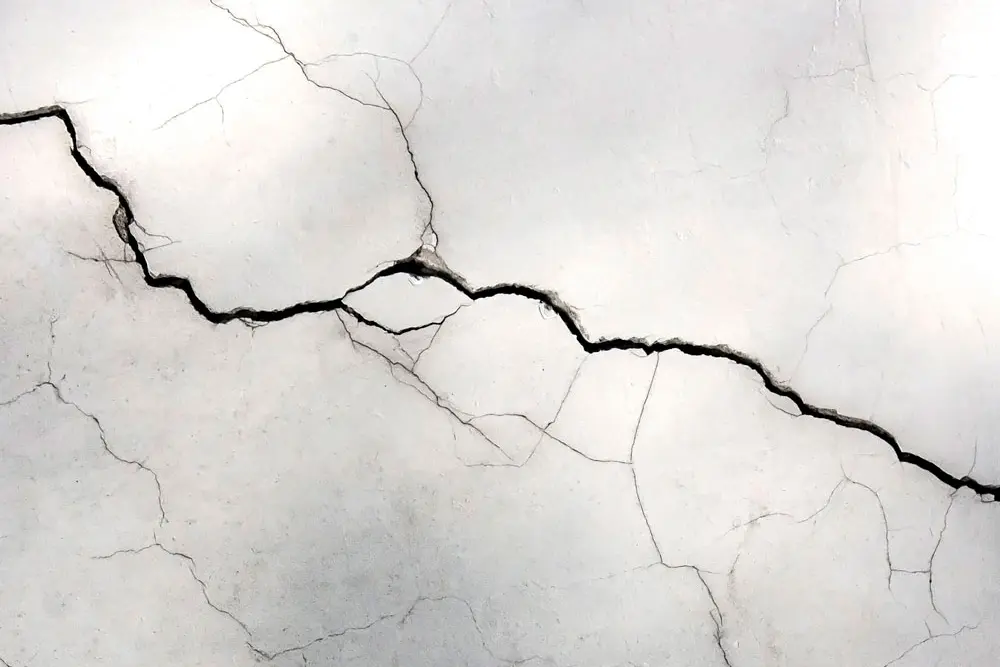Shear and bending fractures are the most important fracture modes for unreinforced beams. Flexural rupture due to softness is generally preferred to shear rupture due to brittleness. Because in soft rupture there is a possibility of redistribution of stress and can be a warning to the user, while in sudden rupture due to lack of prior warning can cause disaster. Below are the types of cracks in concrete and solutions to repair them.
Concrete, like other building materials, shrinks and expands with changes in humidity and temperature, and deforms according to the load and storage conditions. The concrete crack is created when no arrangements are made for these movements in design and execution.
Some types of concrete crack in ordinary concrete are paste cracks, cracks due to plastic shrinkage, shrinkage cracks due to drying, thermal cracks of early ages, shrinkage due to carbonation, cracks due to incorrect connection, cracks Due to continuous external constraints (for example, a wall cast in place along the bottom edge on a strip foundation), basement floor cracks, parallel cracks at the edge of plate fragments due to freezing and thawing, and cracks in snakeskin.
Learn More: Epoxy Floor Thickness
Types of Concrete Crack
Bending Concrete Crack
Occurs alone or in groups when the flexural strength of the concrete section is low and the tensile fiber is the widest and converges to other fibers. This type of concrete crack affects the health of the structure and should be investigated.
Cut Crack
Occurs when the shear strength of the concrete section is low and extends up and down alone or in groups in the area with maximum shear (maximum width in the middle of the depth) and has a great impact on the health of the structure.
Twist Crack
Occurs in a helical form alone in a section with low torsional strength that has a uniform width.
Cracks Related to Slipping Rebar Joints
Occurs due to rapid disconnection of rebars when there is not enough boundary at the joints.
Tensile Crack
Due to the lack of sufficient reinforcement in the section under tension and low quality of concrete occurs.
Concrete Crack in Column
Horizontal cracks occur due to corrosion of the reinforcements and lack of design of the column cross-section for bending. Oblique cracks are caused due to the lack of lateral forces and low resistance to axial load-bearing.
Corrosion Cracks
Due to the corrosion of the reinforcements, insufficient coverage and low quality of concrete occur.
Shrinkage Cracks Due to Drying in Concrete (Shrinkage Cracks)
Leaking water from hardened concrete in unsaturated air will cause shrinkage due to drying. When the concrete dries, the water in the cavities decreases, and the outflow of water from the cavities changes the moisture content of the cement paste, as a result of the above two factors, the concrete shrinks. In fact, it can be said that shrinkage cracks are formed and appear as a result of water loss when the radiance of water disappears from the concrete surface and disappears. Of course, this shrinkage occurs slowly and occurs after several weeks or months. These cracks are usually tangled and straight and occur mainly on the inner surface of the slab and rarely spread to the edge. These cracks are shallow and do not have a serious problem other than an unpleasant change in the appearance of concrete.
Learn More: Prevent Your Floor From Peeling
Shrinkage Due to Carbonation
CO2 in the air, despite the humidity, forms carbonic acid, which forms Ca (OH) 2. Other cement compounds also react and decompose with calcium carbonate resulting from the hydration of cement. After carbonation, some shrinkage occurs in the concrete, which is known as carbonation shrinkage. The carbonation process starts at the concrete surface and continues into it, which is very slow. The rate of carbonation depends on the permeability, amount, and humidity of the concrete, as well as the percentage of O2 and the relative humidity of the air.
Early Age Thermal Cracks
One of the important factors affecting the types of cracks in concrete is the ambient temperature. Concrete pouring in hot weather increases the evaporation rate of concrete water and as a result, the hydration process is not done well and causes cracks in the concrete.
Formation of cracks in hardened concrete due to evaporation from the required initial mixing water, mostly in hot air or due to volumetric evaporation due to cooling from high temperature during concreting to low degrees during operation. In large sections, the difference between the internal and external temperatures may cause stresses that are “sufficient to create cracks in the concrete”.
Hot air also affects the air bubbles. At high temperatures, the concrete will need to increase in the amount of bubbling additive to reach the desired total air content. Figure 2 shows a sample of cracks in the concrete.
Proper Repair of Concrete Crack
In principle, the correct repair of cracks in concrete depends on the occurrence and also the choice of the appropriate method, otherwise, the repairs may be temporary. Therefore, for a successful and permanent repair, it is necessary to ensure that the causes of cracking do not progress, because some common methods used to repair and repair cracks in concrete members may include the following.
- Epoxy resin injection
- Crack navigation and sealing
- Stitch
- Addition of computational rebar
- Drilling and connection
- Heavy feeding
- Fill with grout
Therefore, according to the above, reinforcing concrete structures in place to increase the final capacity and stiffness by an external connection of the composite sheet using epoxy resin seems to be a practical and possible way.
Learn More: How Long Do Epoxy Floors Last?
Composite materials are important in reducing weight and increasing structural performance due to their high strength and rigidity, corrosion resistance, and low specific gravity. Also, the use of these materials due to ease of preparation, installation speed, the possibility of optimization (option of the type of reinforcement and direction), multi-function (strength, rigidity, anti-corrosion) can be considered in structures. These are the main parameters for the selection of composite materials in the reinforcement of structures.

